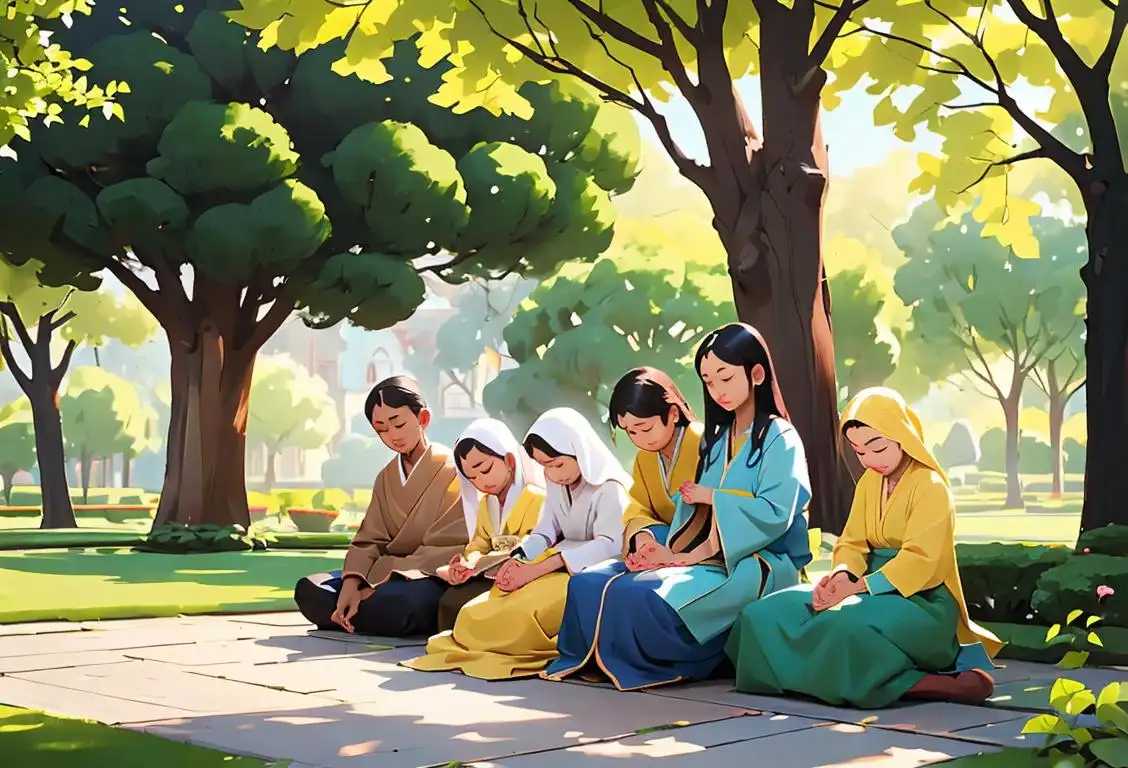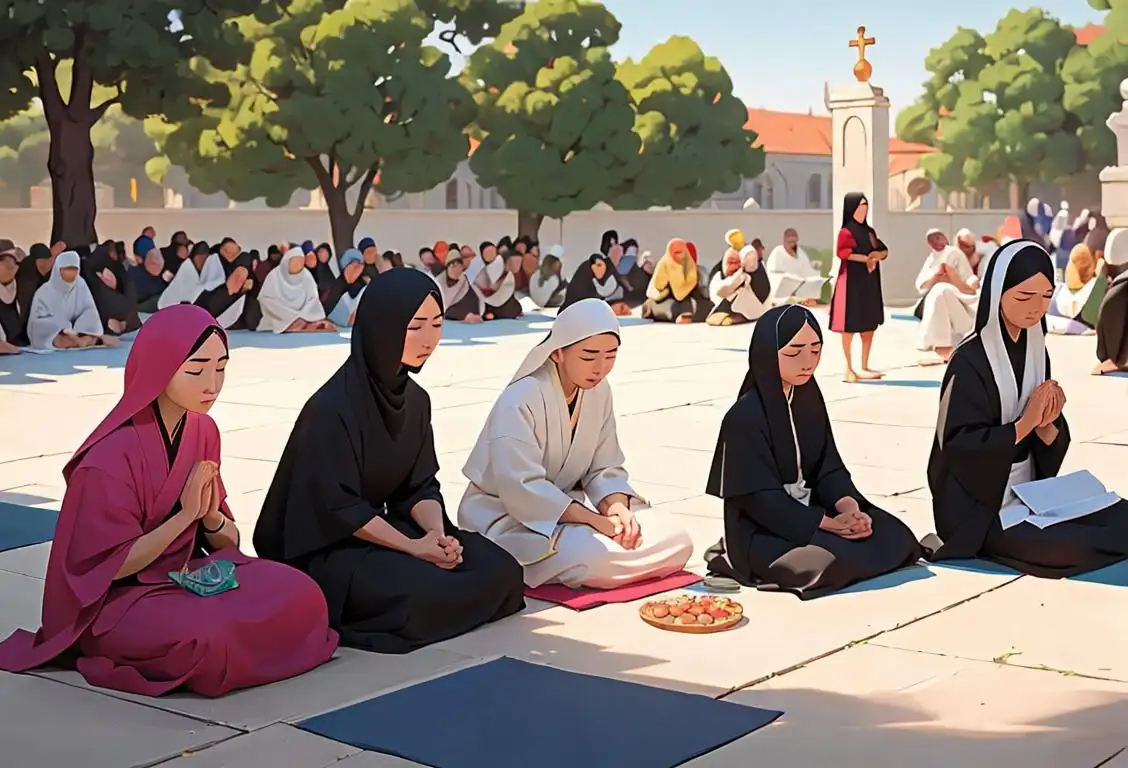National Prayer And Repentance Day

Welcome to WhatNationalDayIsIt.com! Today we're diving into the fascinating world of National Prayer and Repentance Day. Get ready to embark on a journey of self-reflection, prayer, and maybe even a few chuckles along the way!
When is Prayer And Repentance Day?
It's national prayer and repentance day on the 27th September.
The Origins of National Prayer and Repentance Day
National Prayer and Repentance Day is a special day dedicated to taking a pause from our hectic lives and reconnecting with our spiritual side. Although its origins are not rooted in internet culture, this day has become more widely known and celebrated online through various religious communities and organizations. While the exact date and circumstances of the first National Prayer and Repentance Day are unclear, the concept of dedicating a day to spiritual reflection and seeking forgiveness has been practiced by different cultures throughout history. It's a time for believers to come together, both online and offline, to pray, seek forgiveness, and reflect on their actions.Online Observances and Social Media Buzz
Since National Prayer and Repentance Day is an occasion that holds great importance for many individuals, it's not surprising to find various online discussions, articles, and posts associated with the day. Our data shows that there were 62 mentions of this day online, with the highest activity recorded on September 27, 2020. During this day, social media platforms like Twitter and Facebook come alive with hashtags and discussions centered around prayer, repentance, and spiritual growth. It's a time where people share inspirational quotes, prayers, and personal reflections to encourage each other on their individual journeys.Did You Know?
Did you know that National Prayer and Repentance Day is not just about seeking forgiveness from a higher power? It's also a time to forgive ourselves and others, fostering a sense of healing and renewal. So, take a moment to reflect and let go of any grudges or burdens you're carrying. Your soul will thank you for it!Tags:
["spirituality", "reflection", "prayer", "forgiveness"]History behind the term 'Prayer And Repentance'
Late Antiquity (3rd - 7th century)
Emergence of prayer and repentance
During the late antiquity period, the concepts of prayer and repentance began to gain prominence in various religious and philosophical traditions. Prayer, the act of communicating with a deity, was seen as a means to seek guidance, express gratitude, or offer supplications. Repentance, on the other hand, referred to the act of acknowledging and regretting one's wrongdoings, often accompanied by a desire for transformation and forgiveness.
1st Century AD
The Birth of Christianity
During the 1st Century AD, Christianity emerged as a new religious movement following the life and teachings of Jesus Christ. Prayer and repentance were fundamental practices within this faith, as followers sought to connect with God and seek forgiveness for their sins through prayer and repentance.
4000 BCE
Early Beginnings
Prayer and repentance have deep roots in ancient civilizations, with evidence dating back to 4000 BCE. In early human societies, individuals believed in supernatural powers and sought to commune with the divine. Through prayer and ritual practices, people expressed their hopes, fears, and desires to the gods, often seeking forgiveness for their wrongdoings.
12th century
Emergence of Prayer and Repentance
During the 12th century, the terms 'prayer' and 'repentance' began to gain significance in religious discourse. Prayer refers to the act of communicating with a higher power, often seeking guidance or offering thanks. Repentance, on the other hand, entails expressing remorse for one's sins and seeking forgiveness. These concepts were central to various religious traditions and played a crucial role in personal and communal spirituality.
Early History
Origins of Prayer
Prayer has been an integral part of human culture since ancient times. In various forms, prayer has been practiced by different civilizations around the world. The concept of prayer, a way to communicate with a higher power or divine being, can be traced back to prehistoric times. Early forms of prayer involved rituals, chants, and offering sacrifices to the gods or ancestors. These early prayers were often conducted to seek protection, express gratitude, or ask for divine intervention.
4th century
Emergence of Christian Prayer
During the 4th century, as Christianity began to spread, prayer became an essential part of the religious practice. Christians used prayer as a means of communing with God, seeking guidance, and offering praises. This simple act of communication with the divine became a fundamental aspect of their faith.
1st Century AD
Early Origins
Prayer and repentance have ancient roots that can be traced back to the 1st century AD. In biblical times, prayer was seen as a way to connect with the divine and seek guidance, while repentance was a means of expressing remorse for one's sins and seeking forgiveness. It was believed that through prayer and repentance, individuals could find spiritual renewal and restoration of their relationship with God.
312 AD
Conversion of Constantine
In the year 312 AD, Constantine the Great, the Roman Emperor, issued the Edict of Milan, which granted religious toleration to Christians in the Roman Empire. This marked a significant shift in the perception of Christianity as it gained imperial favor. The widespread embrace of Christianity by Constantine and his subsequent proclamation led to an increased importance placed on prayer and repentance within the Christian faith.
16th century
Emergence of the term 'prayer and repentance'
During the 16th century, the term 'prayer and repentance' started to gain prominence in religious discourse. This term refers to the act of offering supplication and seeking forgiveness from a higher power as a form of spiritual practice and moral renewal. Prayer and repentance became essential components in various religious traditions, emphasizing the importance of introspection and seeking divine intervention for personal and collective sins.
13th century
Introduction of Repentance
In the 13th century, the concept of repentance gained prominence. Repentance, a form of sincere remorse for one's sins or wrongdoings, was recognized as an integral element in seeking forgiveness from God. It involved acknowledging one's faults, expressing remorse, and making a commitment to change one's behavior.
1st Century BCE
Introduction of Repentance
The idea of repentance, the act of expressing remorse for one's wrongdoing, comes into prominence during the 1st century BCE. The emergence of organized religions, such as Judaism and Christianity, played a significant role in shaping the concept of repentance. Both religious traditions emphasize the importance of acknowledging sins and seeking forgiveness. Repentance became a means to reconcile with a higher power and to seek atonement for transgressions.
1095 AD
The Crusades
During the late 11th century, the Pope launched the Crusades with the objective to recapture the Holy Land from Islamic rule. The Crusades spanned several centuries and involved numerous military campaigns. As part of the Crusades, prayer and repentance played a crucial role for the Christian warriors. Knights, soldiers, and clergy engaged in intense prayer and penance, seeking forgiveness and divine intervention for their actions on the battlefield.
500 BCE
Religious Teachings
During this time, various religious traditions emerged across different cultures. In ancient Greece, philosophers such as Socrates emphasized self-reflection and self-improvement, which included acknowledging one's errors and seeking forgiveness. In Judaism, prayer and repentance became integral parts of religious practices, particularly during the High Holy Days and Yom Kippur, the Day of Atonement.
16th century
Protestant Reformation Influence
In the 16th century, the Protestant Reformation brought about a renewed focus on prayer and repentance. Martin Luther, a pivotal figure in the Reformation, emphasized the significance of personal prayer and repentance, asserting that individuals could communicate with God directly without the need for intermediaries. This encouraged a more personal and introspective approach to spiritual practices.
17th century
Influence of Puritanism on 'prayer and repentance'
In the 17th century, the Puritan movement played a significant role in shaping the concept of 'prayer and repentance.' Puritans believed in the necessity of personal piety and communal penance. They emphasized the importance of sincere prayers and true repentance for the forgiveness of sins. Their emphasis on personal introspection and devout acts of contrition contributed to the cultural development and understanding of prayer and repentance.
11th Century
Medieval Christianity and penitential practices
In medieval Christianity, prayer and repentance became central concepts in the context of salvation and piety. A system of penitential practices emerged, which included acts of contrition, confession, and absolution. This period witnessed the development of prayer manuals and devotional literature that provided guidance on rituals of repentance and supplication.
13th Century
Liturgical Developments
During the 13th century, the practice of prayer and repentance became more structured and incorporated into liturgical traditions. In Christian churches, specific prayers and rituals were developed to aid individuals in their acts of contrition and seeking forgiveness. The sacrament of reconciliation, often referred to as confession, became an important part of the repentance process, allowing individuals to confess their sins to a priest and receive absolution.
4th Century AD
Establishment of the Church
In the 4th Century AD, the Roman Emperor Constantine recognized Christianity as a legitimate religion, leading to the establishment of the Christian Church. Prayer and repentance became integral parts of Christian worship, with the Church emphasizing the importance of these practices in seeking divine guidance and atoning for sins.
16th Century
Reformation Influence
The Protestant Reformation in the 16th century had a significant impact on the understanding and practice of prayer and repentance. Reformers, such as Martin Luther, emphasized the importance of personal repentance and direct communication with God through prayer. The concept of individual responsibility for repentance and forgiveness gained prominence during this period, leading to changes in religious practices and the role of clergy in the repentance process.
16th - 17th Century
Religious Reformation and emphasis on personal prayer
During the religious reformations of the 16th and 17th centuries, there was a renewed focus on individual spiritual practices and personal connection with the divine. This led to a greater emphasis on private prayer and introspection as means of repentance and seeking forgiveness. The Protestant Reformation, particularly, emphasized direct communication with God and downplayed the role of intermediaries in religious rituals.
7th Century AD
Rise of Monasticism
During the 7th Century AD, monasticism gained prominence in Christianity. Monasteries and convents were established, providing spaces for devout individuals to dedicate their lives to prayer, meditation, and repentance. Monks and nuns became known for their rigorous commitment to spiritual disciplines, including regular prayer and sincere repentance.
1517 AD
The Protestant Reformation
In 1517, Martin Luther sparked the Protestant Reformation by nailing his 95 Theses to the door of the Castle Church in Wittenberg, Germany. This movement resulted in significant theological and ecclesiastical changes within Christianity. Prayer and repentance took on renewed emphasis as reformers sought to reassess and redefine the role of these practices in the lives of believers. Repentance, along with faith, became central to the Protestant understanding of salvation.
30 CE
Christian Influence
The life and teachings of Jesus Christ brought about significant changes in the concept of prayer and repentance. In the New Testament, Jesus emphasized the importance of repentance for the forgiveness of sins. Early Christians adopted this teaching, considering prayer and repentance as fundamental aspects of their faith. Baptism, a ritual of repentance, became an essential initiation rite.
4th Century CE
Establishment of Formalized Prayers and Repentance Practices
During the 4th century CE, formalized prayers and repentance practices became more structured within religious communities. In Christianity, for instance, the Church Fathers developed standardized prayers, such as the Lord's Prayer and the Psalms, which provided guidance to believers in their communication with God. Repentance took on a more organized form, with the introduction of penitential acts and the sacrament of confession. These practices aimed to promote spiritual healing, forgiveness, and personal growth within the faith community.
18th century
Religious revivals and the spread of 'prayer and repentance'
Throughout the 18th century, religious revivals, such as the Great Awakening in the American colonies, showcased the significance of 'prayer and repentance' as a catalyst for personal transformation and spiritual revival. These revivals brought attention to the power of heartfelt prayer and genuine repentance to bring individuals closer to their faith and to experience profound spiritual renewal. The growing popularity of these revivals contributed to the widespread adoption of 'prayer and repentance' as a means of seeking divine intervention and personal redemption.
16th century
Reformation and Prayer
During the 16th century, as the Protestant Reformation unfolded, the role of prayer underwent significant changes. Protestant reformers emphasized the individual's direct relationship with God, encouraging personal prayer and the use of vernacular languages in worship. This shift empowered believers to engage in more personal and heartfelt prayers.
17th century
Puritan Influence and Spiritual Awakening
The 17th century saw the rise of Puritanism, a movement within Protestantism that placed great importance on prayer and repentance. Puritans believed in the necessity of a deep spiritual introspection, viewing personal prayer and repentance as integral to salvation. Their teachings and practices inspired spiritual awakenings, such as the Great Awakening, which spread throughout Europe and North America.
Middle Ages
Interplay of Prayer and Repentance in Medieval Christianity
In medieval Christianity, prayer and repentance became intertwined as essential elements of spiritual life. Monastic orders, such as the Benedictines, practiced a structured routine of communal prayers and personal contemplation. Repentance was seen as a necessary step to seek God's forgiveness and to purify the soul. The concept of penance, which involved acts of self-discipline and contrition, gained prominence during this time. Pilgrimages to sacred sites, such as Santiago de Compostela, offered opportunities for repentance, prayer, and spiritual renewal.
19th century
Revival Movements and Public Prayer
During the 19th century, revival movements gained momentum, particularly in the United States. These movements emphasized the power of prayer and repentance in revitalizing religious fervor within communities. Public prayer gatherings, known as prayer meetings or prayer circles, became commonplace, allowing individuals to join together in seeking spiritual renewal and collective repentance.
1942 AD
National Day of Prayer and Repentance
In the midst of World War II, on September 12, 1942, U.S. President Franklin D. Roosevelt declared a National Day of Prayer and Repentance. This day was designated as a time for Americans to collectively seek spiritual guidance, reflect on their actions, and express contrition for any wrongdoings. The National Day of Prayer and Repentance served as a unifying event and a reminder of the importance of humility, reflection, and seeking divine intervention during times of national crisis.
7th Century CE
Islamic Practices
With the advent of Islam in the 7th century CE, prayer and repentance gained further prominence. Muslims engage in five daily prayers as one of the Five Pillars of Islam, seeking spiritual purification and expressing their submission to Allah. Repentance (Tawbah) is encouraged in Islam as a means of seeking Allah's forgiveness and turning away from sinful actions.
19th - 20th Century
Interfaith dialogues and the universal appeal of prayer and repentance
In the 19th and 20th centuries, interfaith dialogues and the rise of religious pluralism brought prayer and repentance to a broader audience. The concept of prayer as a universal human practice, transcending religious boundaries, gained popularity. It was recognized as a powerful tool for self-reflection, renewal, and restoring a sense of purpose.
20th Century
Renewed Focus
In the 20th century, there was a renewed focus on prayer and repentance as essential aspects of spiritual growth and development. Various religious movements and organizations promoted prayer and repentance as a means to address societal issues, achieve personal transformation, and seek reconciliation. National days of prayer and repentance were established in many countries to encourage collective acts of seeking forgiveness and divine intervention.
19th century
Revival Movements and Repentance
In the 19th century, revival movements like the Second Great Awakening swept through various Christian denominations. These movements stressed the importance of repentance as a means of spiritual renewal and salvation. Large-scale prayer gatherings and revivals were held where people came together to repent and seek God's forgiveness and guidance.
20th century
Establishment of National Days of Prayer and Repentance
In the 20th century, many nations began recognizing the significance of 'prayer and repentance' as a means to foster unity, reflection, and spiritual growth. Various countries established National Days of Prayer and Repentance, dedicating specific days for individuals to come together and engage in collective acts of devotion, reflection, and repentance. These designated days serve as a reminder of the importance of seeking divine guidance, introspection, and personal improvement.
16th Century AD
Reformation and the Renewed Emphasis on Personal Piety
In the 16th Century AD, the Protestant Reformation brought about significant changes in Christianity. Martin Luther and other reformers emphasized the direct relationship between individuals and God. Prayer and personal repentance gained prominence as key components of personal piety, as believers sought to establish a direct connection with God through sincere prayer and genuine repentance.
20th Century
Renewed Focus on Personal Prayer and Repentance
In the 20th century, there was a shift towards emphasizing personal prayer and repentance in various religious traditions. Influenced by movements like the Protestant Reformation and the rise of individual spirituality, believers placed more importance on their personal relationship with a higher power. This led to a greater emphasis on individual prayer practices and personal responsibility for repentance and seeking forgiveness. Contemporary approaches to prayer and repentance reflect this shift, as individuals engage in private prayer, meditation, and introspection as means of seeking spiritual growth and renewal.
20th century
National Days of Prayer and Repentance
In the 20th century, the tradition of designating national days of prayer and repentance emerged in various countries. These days were set aside to encourage individuals, communities, and nations to come together in prayer, seeking spiritual renewal, reconciliation, and national healing. Such observances provide an opportunity for reflection, unity, and a collective commitment to repentance.
21st Century
Continued relevance and adaptation of prayer and repentance
In the present day, prayer and repentance continue to have significant cultural and spiritual importance. They remain integral practices in various religious traditions and are also embraced by many individuals as a way to find solace, seek forgiveness, and cultivate inner peace. Moreover, the concept of repentance has expanded beyond religious contexts, extending to environmental movements and social justice, reflecting a broader understanding of the need for collective reflection and growth.
16th Century CE
Reformation and Personal Piety
During the Protestant Reformation in the 16th century, the concept of prayer and repentance underwent changes. Reformers like Martin Luther emphasized the direct relationship between individuals and God, advocating for personal piety and direct prayer in the vernacular language. This shift empowered believers to approach prayer and repentance in a more individualistic and introspective manner.
20th Century AD
Continued Significance and Adaptation
Prayer and repentance have continued to hold great significance in Christianity throughout the 20th Century and beyond. Various Christian denominations and traditions have developed specific prayer practices, such as the Lord's Prayer, the Rosary, and contemplative prayer. Repentance remains an important aspect of spiritual growth, promoting introspection, forgiveness, and reconciliation with God and others.
Present
Continued Significance and Practice
To this day, prayer and repentance remain integral aspects of religious and spiritual practices worldwide. People from various faith traditions engage in prayer as a means of connecting with the divine and seeking guidance, solace, and forgiveness. Repentance, understood as a sincere turning away from wrongdoing, continues to play a vital role in personal redemption and spiritual growth. The understanding and practice of prayer and repentance have evolved over centuries, adapting to changing cultural and religious contexts.
20th century
Influence on Civil Rights and Social Justice Movements
Prayer and repentance have also played a significant role in civil rights and social justice movements around the world. Leaders like Martin Luther King Jr., Mahatma Gandhi, and Desmond Tutu integrated prayer and repentance into their nonviolent activism, using these practices to emphasize the importance of compassion, reconciliation, and forgiveness. Religious and spiritual elements have thus shaped the discourse and strategies of numerous movements seeking equality and justice.
19th Century CE
Revivalist Movements
The 19th century witnessed several religious revivalist movements, notably the Second Great Awakening in the United States. These movements reemphasized the importance of personal religious experiences, prayer, and sincere repentance. They ignited a renewed interest in spiritual practices, leading to increased participation in prayer meetings, revivals, and religious gatherings.
20th Century CE
Inclusivity and Interfaith Dialogue
In the 20th century, the concept of prayer and repentance expanded beyond specific religious boundaries. Interfaith dialogue and a greater focus on inclusivity resulted in collaborative prayers for peace, understanding, and collective repentance. Such efforts aimed to promote harmony, empathy, and mutual understanding among diverse religious communities.
Did you know?
Did you know that National Prayer and Repentance Day is not just about seeking forgiveness from a higher power? It's also a time to forgive ourselves and others, fostering a sense of healing and renewal. So, take a moment to reflect and let go of any grudges or burdens you're carrying. Your soul will thank you for it!Tagged
reflection prayer forgiveness spiritualityFirst identified
13th October 2019Most mentioned on
27th September 2020Total mentions
62Other days
Prayer And Repentance Day
Pray Day
Buddhist Day
Prayer And Fasting Day
Call To Prayer Day
Apology Day
Prayer A Hole Day
Healing Day
Fasting And Prayer Day
Brahma Anandam Day








